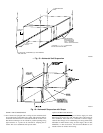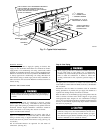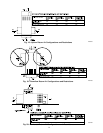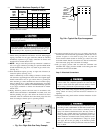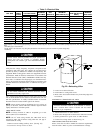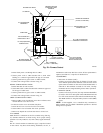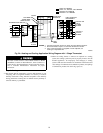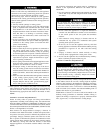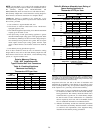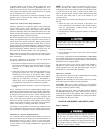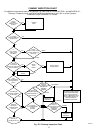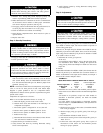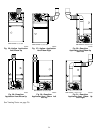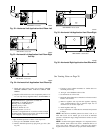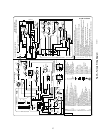
NOTE: See the NFGC, 13.1.9 and 13.2.20 regarding alternative
venting design and the exception, which cover installations such as
the Chimney Adapter Kits KGACA02014FC and
KGACA02015FC, which are listed for use with these furnaces.
The Chimney Adapter Kit is listed alternative venting design for
these furnaces. See the kit instructions for complete details.
Canada-This furnace is permitted to be vented into a clay
tile-lined masonry chimney that is exposed to the outdoors below
the roof line, provided:
1. Vent connector is Type-B double-wall, and
2. This furnace is common vented with at least 1 draft hood-
equipped appliance, and
3. The combined appliance input rating is less than the maximum
capacity given in Table A, and
4. The input rating of each space heating appliance is greater
than the minimum input rating given in the appropriate Table
B for Masonry Chimneys for the local winter design tempera-
ture. Chimneys having internal areas greater than 38 square
inches require furnace input ratings greater than the input
ratings of these furnaces. See footnote at bottom of Table B,
and
5. The authority having jurisdiction approves.
If all of these conditions cannot be met, an alternative venting
design shall be used, such as the listed chimney adapter kit with
these furnaces listed for use with the kit, a listed chimney-lining
system, or a Type-B common vent.
Exterior Masonry Chimney,
FAN + NAT Installations with
Type-B Double-Wall Vent Connectors
Table A—Combined Appliance
Maximum Inut Rating in
Thousands of BTU per Hour
VENT
HEIGHT (FT)
INTERNAL AREA OF CHIMNEY
(SQ. IN.)
12 19 28 38
6 74 119 178 257
8 80 130 193 279
10 84 138 207 299
15 NR 152 233 334
20 NR NR 250 368
30 NR NR NR 404
Table B—Minimum Allowable Input Rating of
Space-Heating Appliance in
Thousands of BTU per Hour
VENT
HEIGHT (FT)
INTERNAL AREA OF CHIMNEY
(SQ. IN.)
12 19 28 38
Local 99% Winter Design
Temperature: 17 to 26 degrees F*
17 to 26 F
6 0 55 99 141
8 52 74 111 154
10 NR 90 125 169
15 NR NR 167 212
20 NR NR 212 258
30 NR NR NR 362
Local 99% Winter Design
Temperature: 5 to 16 degrees F*
5to16F
6 NR 78 121 166
8 NR 94 135 182
10 NR 111 149 198
15 NR NR 193 247
20 NR NR NR 293
30 NR NR NR 377
Local 99% Winter Design
Temperature: -10 to 4 degrees F*
-10 to 4 F
6 NR NR 145 196
8 NR NR 159 213
10 NR NR 175 231
15 NR NR NR 283
20 NR NR NR 333
30 NR NR NR NR
Local 99% Winter Design
Temperature: -11 degrees F or lower*
-11 F or lower
Not recommended for any vent
configuration
*The 99% Winter Design Dry-Bulb (db) temperatures are found in the 1993
ASHRAE Fundamentals Handbook, Chapter 24, Table 1 (United States) and
2 (Canada), or use the 99.6% heating db temperatures found in the 1997 or
2001 ASHRAE Fundamentals Handbook, Climatic Design Information chap-
ter, Table 1A (United States) and 2A (Canada).
Inspections before the sale and at the time of installation will
determine the acceptability of the chimney or the need for repair
and/or (re)lining. Refer to Fig. 25 to perform a chimney inspection.
If the inspection of a previously used tile-lined chimney:
a. Shows signs of vent gas condensation, the chimney should
be relined in accordance with local codes and the authority
having jurisdiction. The chimney should be relined with a
listed metal liner, Type-B vent, or a listed chimney adapter
kit shall be used to reduce condensation. If a condensate
drain is required by local code, refer to the NFGC, Section
10.9 for additional information on condensate drains.
b. Indicates the chimney exceeds the maximum permissible
size in the tables, the chimney should be rebuilt or relined
to conform to the requirements of the equipment being
installed and the authority having jurisdiction.
20



